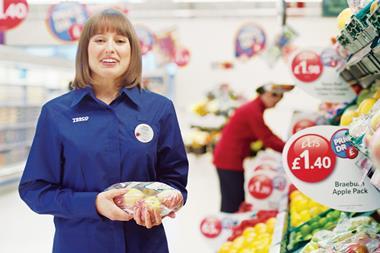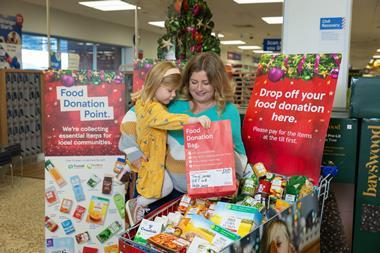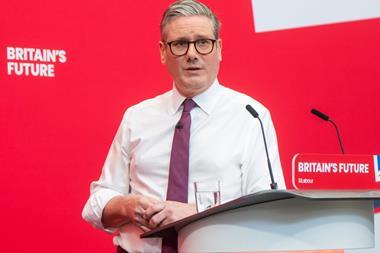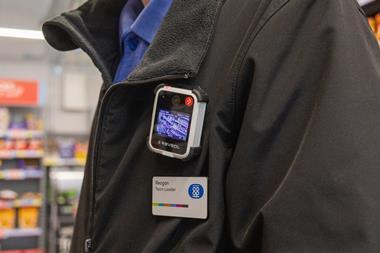Group sourcing has been used for non food lines for a while now, but as Tesco employs the same strategy for some of its grocery lines, should the competition be worried? James Durston reports
They say size isn't everything, it's what you do with it that counts. If that is true Tesco is on to a winner. It is not only one of the biggest retailers in the world, it is using that size to bolster its performance in ways that leave the competition looking rather puny in comparison. It recently revealed it will soon be sourcing 500 of its grocery lines from Continental Europe, which will allow it to get lower prices and better control of suppliers. So how far could it go?
This 'group sourcing', where products for different markets are bought in a single transaction, isn't new. It has been used by non food retailers and the ???multiple grocers for their non food lines for some time. But it is the first time a retailer is doing similar things for some of its grocery lines - and as global grocery brands and products vary less and less across international borders, it could be the start of a whole new strategy for Tesco.
Tesco already knows what a difference group sourcing can make. As well as a good proportion of its clothing and hardlines, half of Tesco's European fresh produce is now group sourced from six European countries, reducing costs by 10%. This gives it more room to lower prices. Greg Lawless, retail analyst at HSBC, says: "The savings Tesco makes won't go straight to the bottom line. They'll reinvest the margin to reduce the retail price. It's not rocket science."
Now, as Tesco goes truly global, it makes sense to trial this model in other areas, such as grocery. "Leveraging scale" is how Tesco's commercial and trading director Richard Brasher put it in a recent presentation about its global sourcing. Deloitte's head of fmcg, Ed Hudson, says: "One of the easier ways for retailers to cut costs is to centralise their procurement. Typically these functions are located in low tax jurisdictions, so you not only get the benefit of better discounts for the aggregated purchasing, you also get lower tax rates."
That explains why Tesco is starting in Central Europe. A Tesco spokesman says: "In Central Europe there are many similarities across the grocery category and we are looking to source a number of grocery lines. This is good news for local suppliers who have the opportunity to supply Tesco stores across Europe."
The multiple confirms that lines such as biscuits and tinned foods will be sourced this way, and there is word that its citrus sourcing is another. But generally, any grocery product that doesn't need a local variation could be considered, be it orange juice, rice or other branded goods. Tesco says: "Providing a local offer is one of our key strengths and we look at buying jointly where it doesn't compromise the needs of our local customers."
So what are the benefits? Firstly, bigger volumes mean better discounts. Unilever, which uses a global procurement centre to buy 66% of its products, claims to have gained a 2% margin uplift from its group sourcing initiatives. Secondly, it eliminates much of the complexity usually found in a global supply chain.
"Tesco's international ambitions mean that they're finding new suppliers in new locations, and there's a whole range of considerations they need to think about," says Hudson. "They need to balance seasonality with availability, they need to look at how to dispatch the goods, customs and excise charges, transport costs and so on. The best way to control this complexity is to source things centrally."
But there are risks. Consumers in the UK are demanding more locally sourced food and might turn their noses up at biscuits from Hungary, say. Plus, group sourcing can result in increased lead times for delivery, over-reliance on a few suppliers and problems with stockholding.
Those problems don't concern Tesco, though: "Group sourcing allows us to buy bigger volumes at lower prices, which means unbeatable range and prices for customers," says a spokesman.
So if it is that advantageous, will Tesco soon be sourcing 5,000 grocery lines, rather than 500, from Europe? Could it start looking further afield for its groceries, too? David McCarthy, managing director of European food retail research at Citigroup, says: "For many years I've been saying that global buying synergies for food don't exist," he says. "But they are now starting to develop. Tesco is at the forefront of this development, and if there are any advantages to be had from global sourcing then Tesco will be on to them."
Produce is already being sourced from Europe in significant volumes, and the nature of fresh food means it is unlikely that this could be extended to Asia, for example. But grocery lines are a different matter, and if this initial foray succeeds, there is no reason, save the usual hurdles with haulage costs and so on, why it couldn't happen outside Europe, too.
Tesco certainly won't be shy of using its international coverage as an extra weapon against the competition. Morrisons and Sainsbury, operating in the UK only, just don't have access to the same devices, and although Asda has benefited from the extra reach of Wal-Mart, so far this hasn't included food lines, so it doesn't have the first-mover advantage in these markets. The picture must be worrying for those who like to compete on price.
Not one to do things by half, Tesco has also rejigged its corporate purchasing. It is now sourcing £6m of its refrigeration from China, at a 35% saving on the UK price, and is sourcing all its office PCs directly from Dell, saving £1.1m.
Size may not be everything in the world of retail, but in Tesco's case it certainly seems to be helping.
International sourcing - key facts
International sourcing
Group sourcing from Europe
They say size isn't everything, it's what you do with it that counts. If that is true Tesco is on to a winner. It is not only one of the biggest retailers in the world, it is using that size to bolster its performance in ways that leave the competition looking rather puny in comparison. It recently revealed it will soon be sourcing 500 of its grocery lines from Continental Europe, which will allow it to get lower prices and better control of suppliers. So how far could it go?
This 'group sourcing', where products for different markets are bought in a single transaction, isn't new. It has been used by non food retailers and the ???multiple grocers for their non food lines for some time. But it is the first time a retailer is doing similar things for some of its grocery lines - and as global grocery brands and products vary less and less across international borders, it could be the start of a whole new strategy for Tesco.
Tesco already knows what a difference group sourcing can make. As well as a good proportion of its clothing and hardlines, half of Tesco's European fresh produce is now group sourced from six European countries, reducing costs by 10%. This gives it more room to lower prices. Greg Lawless, retail analyst at HSBC, says: "The savings Tesco makes won't go straight to the bottom line. They'll reinvest the margin to reduce the retail price. It's not rocket science."
Now, as Tesco goes truly global, it makes sense to trial this model in other areas, such as grocery. "Leveraging scale" is how Tesco's commercial and trading director Richard Brasher put it in a recent presentation about its global sourcing. Deloitte's head of fmcg, Ed Hudson, says: "One of the easier ways for retailers to cut costs is to centralise their procurement. Typically these functions are located in low tax jurisdictions, so you not only get the benefit of better discounts for the aggregated purchasing, you also get lower tax rates."
That explains why Tesco is starting in Central Europe. A Tesco spokesman says: "In Central Europe there are many similarities across the grocery category and we are looking to source a number of grocery lines. This is good news for local suppliers who have the opportunity to supply Tesco stores across Europe."
The multiple confirms that lines such as biscuits and tinned foods will be sourced this way, and there is word that its citrus sourcing is another. But generally, any grocery product that doesn't need a local variation could be considered, be it orange juice, rice or other branded goods. Tesco says: "Providing a local offer is one of our key strengths and we look at buying jointly where it doesn't compromise the needs of our local customers."
So what are the benefits? Firstly, bigger volumes mean better discounts. Unilever, which uses a global procurement centre to buy 66% of its products, claims to have gained a 2% margin uplift from its group sourcing initiatives. Secondly, it eliminates much of the complexity usually found in a global supply chain.
"Tesco's international ambitions mean that they're finding new suppliers in new locations, and there's a whole range of considerations they need to think about," says Hudson. "They need to balance seasonality with availability, they need to look at how to dispatch the goods, customs and excise charges, transport costs and so on. The best way to control this complexity is to source things centrally."
But there are risks. Consumers in the UK are demanding more locally sourced food and might turn their noses up at biscuits from Hungary, say. Plus, group sourcing can result in increased lead times for delivery, over-reliance on a few suppliers and problems with stockholding.
Those problems don't concern Tesco, though: "Group sourcing allows us to buy bigger volumes at lower prices, which means unbeatable range and prices for customers," says a spokesman.
So if it is that advantageous, will Tesco soon be sourcing 5,000 grocery lines, rather than 500, from Europe? Could it start looking further afield for its groceries, too? David McCarthy, managing director of European food retail research at Citigroup, says: "For many years I've been saying that global buying synergies for food don't exist," he says. "But they are now starting to develop. Tesco is at the forefront of this development, and if there are any advantages to be had from global sourcing then Tesco will be on to them."
Produce is already being sourced from Europe in significant volumes, and the nature of fresh food means it is unlikely that this could be extended to Asia, for example. But grocery lines are a different matter, and if this initial foray succeeds, there is no reason, save the usual hurdles with haulage costs and so on, why it couldn't happen outside Europe, too.
Tesco certainly won't be shy of using its international coverage as an extra weapon against the competition. Morrisons and Sainsbury, operating in the UK only, just don't have access to the same devices, and although Asda has benefited from the extra reach of Wal-Mart, so far this hasn't included food lines, so it doesn't have the first-mover advantage in these markets. The picture must be worrying for those who like to compete on price.
Not one to do things by half, Tesco has also rejigged its corporate purchasing. It is now sourcing £6m of its refrigeration from China, at a 35% saving on the UK price, and is sourcing all its office PCs directly from Dell, saving £1.1m.
Size may not be everything in the world of retail, but in Tesco's case it certainly seems to be helping.
International sourcing - key facts
International sourcing
Group sourcing from Europe



















No comments yet